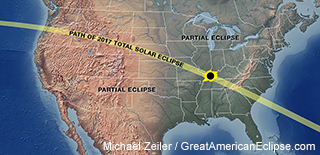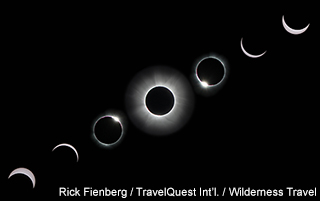Solar Eclipse Website & Mini-Grants Program Launched

Richard Fienberg Running Hare Observatory
This post is adapted from an American Astronomical Society press release:
The AAS has launched a new website, eclipse.aas.org, to help prepare the country for next year’s most anticipated celestial spectacle: the first total eclipse of the Sun to touch the US mainland since 1979 and the first to span the continent since 1918. With support from the National Science Foundation (NSF), the AAS has also unveiled a program of small grants to fund educational activities aimed at engaging the public with the eclipse (application deadline: 13 January 2017).
On Monday, 21 August 2017, a total solar eclipse will darken a roughly 70-mile-wide swath of the US from Oregon (a little after 10 am PDT) to South Carolina (a little before 3 pm EDT). Millions of citizens and visitors will have a chance to see the ethereal solar corona and experience “darkness at midday.” Outside this narrow path of totality, all of North America will have a partial solar eclipse.The event is being called the Great American Eclipse or All-American Eclipse because the Moon’s dark shadow crosses the entire continental US but touches no other country as it travels 8,600 miles across Earth’s surface. The eclipse presents a unique opportunity to excite people about science and connect them personally to the cosmos. Yet it also presents unique challenges: everyone in the country needs to learn how to view the eclipse safely, and communities along the path of totality need to be ready for an unprecedented influx of visitors.
To address these opportunities and challenges, the AAS has established a solar eclipse task force. Its co-chairs are Shadia R. Habbal (University of Hawaii Institute for Astronomy) and Angela Speck (University of Missouri, Columbia). Their colleagues on the AAS task force make up a Who’s Who of eclipse experts representing many relevant communities, including amateur and professional astronomers, educators, doctors, journalists, and government officials.
Several excellent solar-eclipse websites already exist thanks to the efforts of a handful of individual amateur and professional astronomers as well as NASA. “Rather than ‘reinvent the wheel,’” says Habbal, “eclipse.aas.org offers a modest amount of high-level information to get people started and then provides links to more detailed information on other sites. It’s a curated guide to the best and most reliable resources on solar eclipses in all media.”
A total solar eclipse is about as bright as the full Moon and just as safe to look at, but the Sun at any other time, including during a partial eclipse, is dangerously bright and must be viewed through special-purpose safe solar filters. There’s a lot of confusion about this. Accordingly, the AAS task force has taken great care to publish reliable, trustworthy eye-safety information on eclipse.aas.org. The AAS’s eclipse-viewing instructions have been adopted for use by NASA and endorsed by the American Academy of Ophthalmology and American Academy of Optometry.With funding provided by the NSF, the AAS Solar Eclipse Task Force has also issued a call for proposals for $1,000 to $5,000 grants to engage the public via eclipse-related education and outreach activities in venues such as science museums, planetariums, libraries, afterschool programs, and colleges. “Highest priority will be given to programs specifically designed to engage meaningfully with under-represented groups,” says Speck, “who often don’t imagine themselves in science careers or who believe that science is ‘not for them.’” The program is named for Julena Steinheider Duncombe (1911-2003), an outstanding astronomer and educator who started the US’s first school-lunch program for underprivileged children. For many years she published eclipse predictions for the US Naval Observatory. Several towns in Nebraska where she taught school will be in the path of the Moon’s shadow next August 21st. The deadline for grant applications is 13 January 2017.



